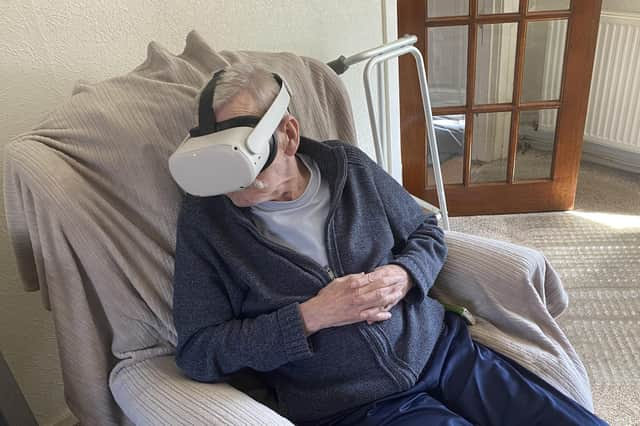Strathcarron Hospice trials virtual reality technology with patients in the community across Falkirk district


Last year the Fankerton hospice received £10,000 from Grangemouth Rotary Club to buy VR equipment, including a headset and a 360-degree camera to provide distraction therapy.
Immersing the patient – be it on a safari, deep sea diving or even visiting their own garden – the technology helps trick the brain into being present in another reality. This can overwhelm the brain with information, leading to a reduction in anxiety and pain.
Advertisement
Hide AdAdvertisement
Hide AdThe 360-degree camera allows the hospice teams to create personalised content for patients who might want to see and experience their favourite place, but are unable to do so physically.
Many patients within the hospice’s in patient unit have benefited from the innovation already, and now it’s being extended to those in local communities.
Kenny Brawley from Grangemouth trialled the VR headset in his home, with Gillian McNab, a clinical nurse specialist in the community, just days before he died.
Gillian said: “It was so important for Kenny to be able to see his beloved holiday spot in Portugal, as unfortunately he was unable to travel since he and his wife sold up his timeshare a few years ago. He told me that they had been making their annual summer trip for many years, and that he longed to go back, but was no longer able. I really sensed Kenny’s sadness, so I mentioned that we had a VR headset and he could be potentially ‘transported’ back to Portugal. He smiled and said ‘yeah, why not’. His wife Marion also got to experience the VR headset which meant that they could both chat about what they had seen and relive precious times together.”
Advertisement
Hide AdAdvertisement
Hide AdMarion said: “It was brilliant to see Kenny so immersed in all these different holiday experiences in Portugal through the VR headset. Whilst I was watching him I could tell he was enjoying it. When he took off the headset, she looked so calm – it was quite emotional for us both.”
The technology has given countless hospice patients the ability to see places and experience new things that they’ve perhaps always wanted to do, without leaving the comfort and safety of their bed in the hospice or their own home. The benefits extend beyond the patient offering a shared experience that can bridge the gap created by life limiting illness and restricted mobility, giving family members one more positive memory to keep close.
Joy Rafferty, specialist doctor, Strathcarron Hospice said: “There are a lot of potential benefits in using VR in palliative care. By providing an experience that transports the patient somewhere else, it could reduce pain and anxiety. VR makes it possible for hospice patients to enjoy amazing experiences regardless of their physical and mental limitations. Because all you need is a VR headset and the right video footage, the possibilities are endless”.